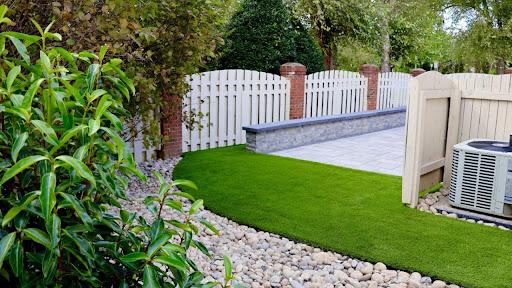Blogs

How To Lay Artificial Turf On Grass?
To lay artificial turf on grass, remove existing grass, compact a crushed stone base for stability, and add an underlay. Roll out the turf, trim edges, secure it with staples or adhesive, and add infill for support. Brush evenly and maintain regularly for best results.
Transforming your lawn with artificial turf offers a low-maintenance, evergreen solution. While installing over existing grass isn’t ideal due to uneven surfaces and weeds, it can be achieved with proper preparation. At Greystone Hardscapes, we specialize in high-quality outdoor transformations in Charlotte, NC. From artificial turf to custom hardscaping, our expert team delivers tailored solutions to elevate your space.
Key Takeaways
Remove grass and debris for a smooth base.
Compact crushed stone or gravel for stability and drainage.
Use underlay and adhesive for proper installation.
Brush in infill to maintain turf integrity.
Perform regular maintenance for longevity.
Step-by-Step Guide: How to Lay Artificial Turf for a Perfect Lawn
Preparation Steps:
Choose a Dry Day: Start on a dry day to ensure proper installation conditions.
Clear the Area: Remove all grass, debris, and roots. Use a shovel or turf cutter to dig about 2 inches into the soil for a clean base.
Create a Base: Lay crushed stone or gravel (MOT type 1) as the foundation for stability and drainage. Compact it firmly.
Installation Steps:
Install Underlay: Roll out underlay material for cushioning and drainage. Secure it with landscape tacks spaced evenly.
Lay Artificial Grass: Roll out the turf, leaving extra material on edges for trimming. Allow it to relax for a few hours to reduce wrinkles.
Cut and Fit: Trim the edges with a sharp knife, ensuring neatness and uniform pile direction.
Secure the Turf: Fold back edges and apply adhesive along the perimeter. Use landscape staples or nails for additional security.
Add Infill: Spread kiln-dried sand or infill evenly to weigh down the turf and maintain its appearance. Brush it in thoroughly.
Final Touches:
After installation, avoid foot traffic for at least two hours to let the adhesive set. Regular brushing and cleaning will keep your turf looking fresh.
Benefits of Artificial Turf for Homeowners
Artificial turf is a low-maintenance, eco-friendly alternative to natural grass, offering year-round greenery. It’s perfect for busy families or drought-prone areas and provides significant cost savings.
Saves on water and fertilizer costs
Durable for high-traffic areas
Eliminates mowing and edging
Eco-friendly and reduces maintenance time
Ideal for drought-prone regions
How to Maintain Artificial Turf
Artificial turf requires minimal maintenance to keep it looking fresh and vibrant. Simple regular care ensures its longevity and functionality.
Brush fibers to keep them upright
Remove debris and clean spills
Hose down to remove dust and dirt
Replenish infill materials as needed
Sanitize pet areas occasionally
Choosing the Right Artificial Turf for Your Yard
Selecting artificial turf involves considering your yard’s specific needs and intended use. The right turf enhances usability and aesthetics.
Opt for nylon or polyethylene for durability
Choose UV-resistant options for sunny areas
Short pile heights for play areas or safety
Consider budget and warranty options
Match color and texture to your design
The Environmental Impact of Artificial Turf
Artificial turf helps conserve water and reduce fertilizer use, but its synthetic materials require responsible disposal. Eco-conscious innovations are shaping its future.
Reduces water usage significantly
Eliminates harmful chemical fertilizers
Long-lasting with proper care
Choose recyclable turf options
Plan for recycling at its end of life
Artificial Turf vs. Natural Grass: Which is Better?
Artificial turf and natural grass each have advantages. The best choice depends on priorities like upfront costs, maintenance, and aesthetics.
Artificial turf: Durable, low-maintenance, water-saving
Natural grass: Eco-friendly, absorbs carbon dioxide
Turf is ideal for high-traffic or shaded areas
Grass offers a traditional, natural aesthetic
Consider long-term costs and environmental goals
Frequently Asked Questions About Artificial Turf
How long does artificial turf need to settle?
Artificial turf typically needs about 24-48 hours to settle after installation to allow the fibers to relax and reduce wrinkles.
Can you put artificial turf directly on the dirt?
It’s not recommended to lay artificial turf directly on dirt. A proper base, such as crushed stone or gravel, is required for stability and drainage.
What are the pros and cons of artificial turf?
Pros include low maintenance, water-saving, durability, and a green lawn year-round. Cons include higher initial cost, being made from synthetic materials, and the need for proper disposal at the end of its lifespan.
Do you have to vacuum artificial turf?
No, vacuuming isn't necessary. Regular brushing and hosing down to remove debris are sufficient to maintain artificial turf.
Contact Us for Artificial Turf Services in Charlotte, NC Now!
Ready to transform your outdoor space? At Greystone Hardscapes, we specialize in premium artificial turf installations and custom hardscaping solutions in Charlotte, Weddington, Waxhaw, Wesley Chapel, and nearby areas. Contact us today for a free quote!
You Dream It.
We Build It.
Superiror Craftmanship.
Every Time.
Hardscape Services:
Copyright © Greystone Hardscapes Inc. 2024. All Rights Reserved. Privacy Policy. Terms & Conditions. Web Design by Fused Media

